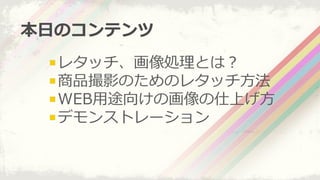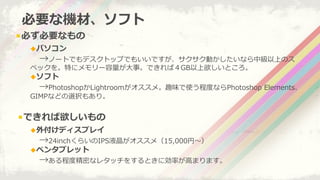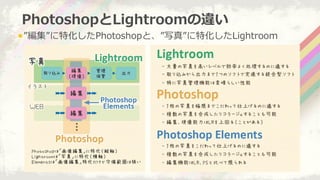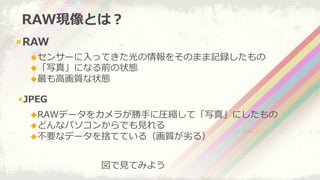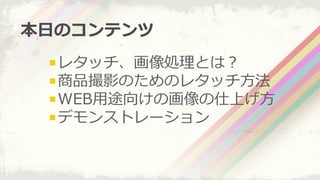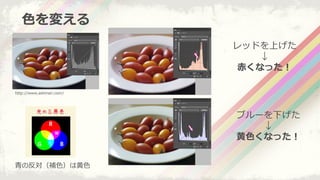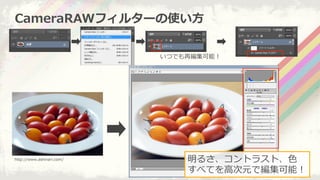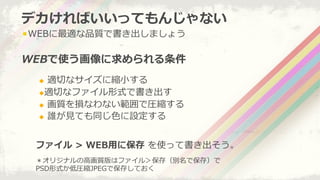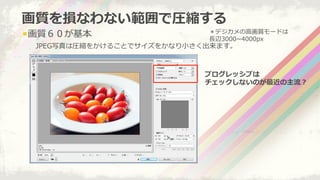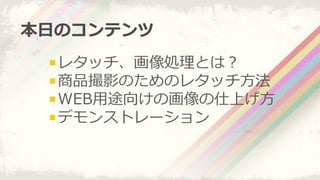撮った后が胜负!商品撮影のための笔丑辞迟辞蝉丑辞辫レタッチ入门
- 5. ! ?レタッチ、画像処理理とは? ! ?商品撮影のためのレタッチ?方法 ! ?WEB?用途向けの画像の仕上げ?方 ! ?デモンストレーション 本?日のコンテンツ
- 8. ! ?必ず必要なもの 必要な機材、ソフト u??パソコン ? →ノートでもデスクトップでもいいですが、サクサク動かしたいなら中級以上のス ペックを。特にメモリー容量量が?大事。できれば4GB以上欲しいところ。 u??ソフト ? →PhotoshopかLightroomがオススメ。趣味で使う程度度ならPhotoshop ?Elements、 GIMPなどの選択もあり。 ! ?できれば欲しいもの u??外付けディスプレイ ? →24inchくらいのIPS液晶がオススメ(15,000円?~) u??ペンタブレット ? →ある程度度精密なレタッチをするときに効率率率が?高まります。
- 9. Adobe写真家向けプログラム ! ??月額980円でPhotoshop、Lightroomが使い放題 u?? ?LightoomとPhotoshop ?CC ?(+ ?Bridge ?CC)が使?用可能。 u?? ?Lightroom ?mobile ?が使?用可能。 u?? ?20GBのオンラインストレージが使?用可能。 u?? ?メジャーバージョンアップしても最新版を使?用可能。 u?? ?毎?月のお布施が必要。。 毎?月980円で?高品質なレタッチが出来るなら?高くはない。。はず。。
- 13. ! ?レタッチ、画像処理理とは? ! ?商品撮影のためのレタッチ?方法 ! ?WEB?用途向けの画像の仕上げ?方 ! ?デモンストレーション 本?日のコンテンツ
- 16. コントラスト カチッとしたもの、 ?黒背景のものはコントラスト ?高めがオススメ 「シャドウハイライト」 ?or ?「トーンカーブ」がオススメ 可愛らしさ、優しさを 出したいなら コントラストは低め!
- 25. ! ?レタッチ、画像処理理とは? ! ?商品撮影のためのレタッチ?方法 ! ?WEB?用途向けの画像の仕上げ?方 ! ?デモンストレーション 本?日のコンテンツ
- 26. ! ?WEBに最適な品質で書き出しましょう WEBで使う画像に求められる条件 デカければいいってもんじゃない u?? ?適切切なサイズに縮?小する u??適切切なファイル形式で書き出す u?? ?画質を損なわない範囲で圧縮する u?? ?誰が?見見ても同じ?色に設定する ファイル ?> ?WEB?用に保存 ?を使って書き出そう。 *オリジナルの?高画質版はファイル>保存(別名で保存)で PSD形式か低圧縮JPEGで保存しておく
- 30. 画質100 画質80 画質60 画質40 画質20 152KB 70KB 42KB 26KB 19KB 画質60が 画質とサイズの バランスが 最も良良い!
- 31. ! ?レタッチ、画像処理理とは? ! ?商品撮影のためのレタッチ?方法 ! ?WEB?用途向けの画像の仕上げ?方 ! ?デモンストレーション 本?日のコンテンツ





